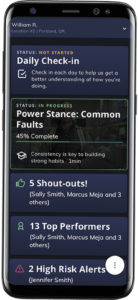Going Mobile: Next Frontier in Employee Safety
By: Ben Kanner, Contributor

There is much to be gained from empowering workers with tailor-made software and mobile devices. (photo courtesy Worklete)
Mobile device use is now ubiquitous in the working world, allowing everyone to stay connected, whether employees are at home or on-site. This is especially important for those on the frontlines. According to a report by IDC, frontline workers account for 57% of American workers. They are continuously on the move—loading and driving trucks; re-stocking shelves; and doing everything they can to ensure that the rest of us get the products and services we need.
And yet, per the IDC report, only 49% of frontline workers are enabled with mobile devices. Separately, a report by Skedulo found that less than half (39%) of deskless workers use software that’s built for their specific needs, and only 13% feel their needs are being met by solutions that were developed for their roles.
There is clearly a disconnect between what frontline workers need and what they receive, but there is still much to gain from empowering these individuals with tailor-made software and mobile devices. The proliferation of smartphones means that vital information can be delivered directly to employees on the job. From how-to videos and step-by-step guides to entire books and endless webpages of information, mobile devices have brought a world of education into the palm of their hands.
Smartphones also make it possible for organizations to deploy microlearning modules—which consist of compact bursts of information—that can be accessed by workers whenever and wherever they want. The information can be tailored to an individual employee’s specific job role or function, and may be quickly absorbed and easily understood when time is short and urgent tasks need to be completed. And, given the speed and efficiency with which microlearning modules can deliver the right knowledge at precisely the right moment, organizations may be tempted to dive in as soon as possible. But, before taking the plunge, they should consider the best ways to approach a frontline employee mobile learning program.
Save Time, Empower Staff with Relevant Microlearning
Safety training is ineffective and inefficient if it is not specifically built for each job role and even each individual—and then appropriately delivered to the right employees at the right time. At a time when frontline worker demands are high and uncertainty about the future is holding strong, employees have to contend with the added stress of an ongoing pandemic. They may be worried about the risk of exposure and what that means for their health or the health of their loved ones.
With these and other concerns, and few moments to spare, organizations cannot afford to take up employee time with education that isn’t applicable to their job. Learning has to be specific, efficient, effective and fit with how companies and employees work, because the number-
one priority is getting the job done.
This is particularly important for highly efficient and distributed workforces, in which every minute matters. By taking the time to do it right from the start, microlearning can offer the fast, targeted approach that employees need to learn quickly and get back to work.
But that’s just one piece of the puzzle. To ensure that workers have an optimal learning experience, employers should consider using a dedicated app.
Amplify Microlearning with the Right Application

To ensure workers have an optimal learning experience, employers should consider using a dedicated app. (photo courtesy Worklete)
Not surprisingly, mobile users tend to prefer dedicated apps that were designed for a specific use case. This was highlighted in Ericsson’s Mobility Report, which found that web browsing only accounted for a sliver of overall mobile traffic, with app-based usage taking up the rest. Users have come to appreciate the simplicity and added functionality of having all of an app’s content in one common destination. By using an app to distribute a microlearning program, organizations can better serve and more seamlessly educate their employees.
After putting the program into place, employers should then consider how it will reach end-users: via personal or company-owned devices?
Increase Productivity with a BYOD Approach
Mobile devices are just that—mobile—so most employees are likely to carry their personal devices while on the job. In fact, more than four fifths (81%) of Americans now own a smartphone. Take advantage of that (and encourage it) by implementing a Bring Your Own Device (BYOD) policy. The benefits are quite significant: BYOD provides employees with easy access to resources that unlock accelerated skill-building and increase productivity, on and off the job.
Most notably, a BYOD policy means that employers aren’t forced to acquire new devices for each individual employee. This reduces the bottom line, while enabling employees to choose exactly which device to use—instead of having managers who make that choice for them. And, when employees use the device they want, they are more likely to be engaged and ready to embrace their safety training.
Deploy a Microlearning Program That Works
Employees don’t have to work from home in order to take advantage of a training program that provides valuable information at any time and from any location. They can learn in real time – on the job, at home or wherever they may be—while the microlearning module provides managers with the user engagement metrics and feedback they need to build better, stronger and more resilient enterprises. This level of flexibility means that workers are more likely to engage with their safety training on a more frequent basis. And, when they do, their employers can expect to see a decrease in injuries.
Ben Kanner is Co-Founder and CEO of Worklete.
Share on Socials!
Safe Confined Space Entry for Cement Silos and Hoppers
The “Right Stuff:” Chemical Protection & Gloves
Next-Gen Products to Help Workers Breathe More Easily
Leaders in Industrial Hygiene
Council for Accreditation in Occupational Hearing Conservation (CAOHC)
Subscribe!
Sign up to receive our industry publications for FREE!









